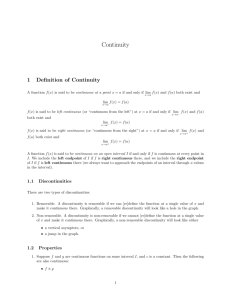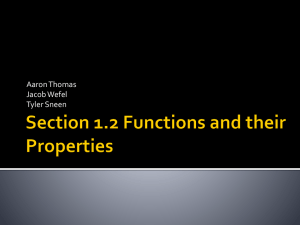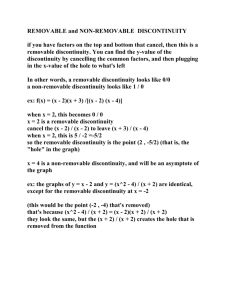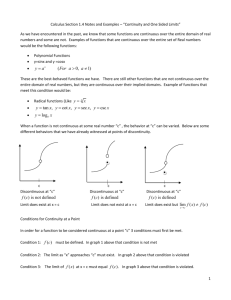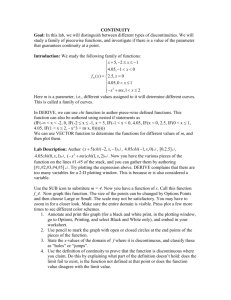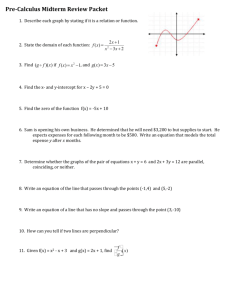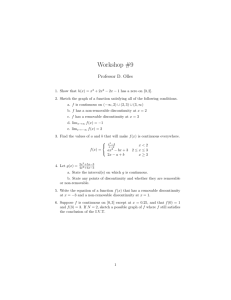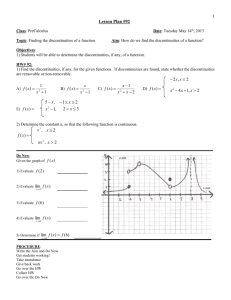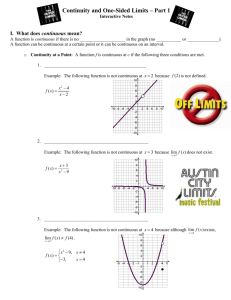Continuity in Calculus: Notes and Examples
advertisement
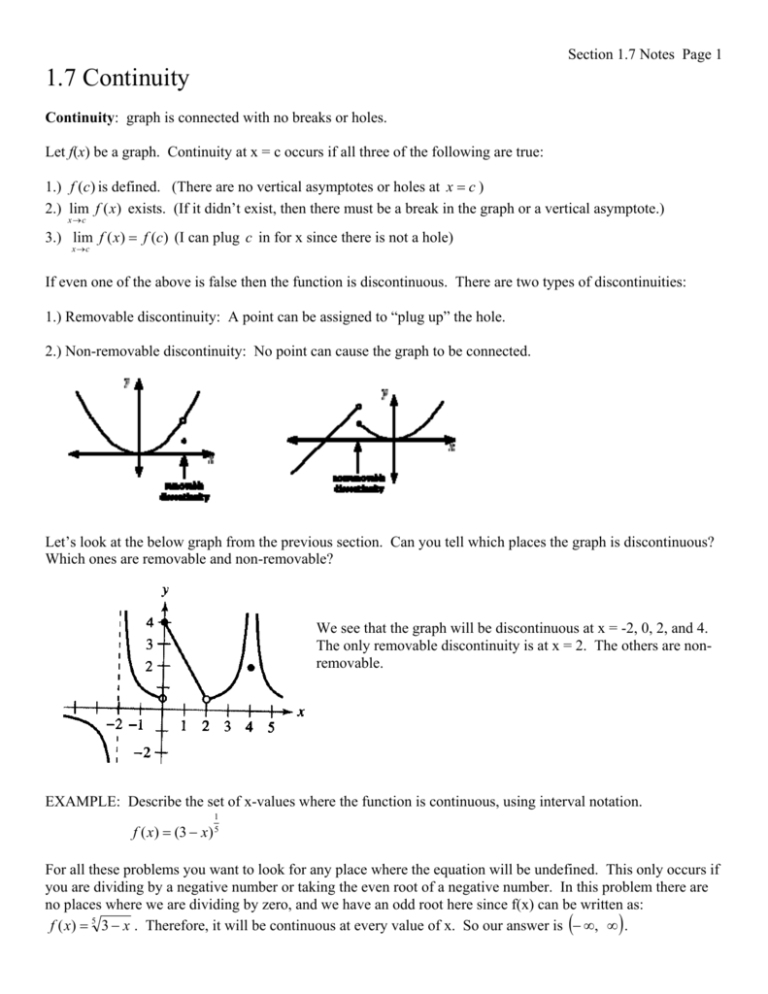
Section 1.7 Notes Page 1 1.7 Continuity Continuity: graph is connected with no breaks or holes. Let f(x) be a graph. Continuity at x = c occurs if all three of the following are true: 1.) f (c) is defined. (There are no vertical asymptotes or holes at x c ) 2.) lim f ( x) exists. (If it didn’t exist, then there must be a break in the graph or a vertical asymptote.) x c 3.) lim f ( x) f (c) (I can plug c in for x since there is not a hole) x c If even one of the above is false then the function is discontinuous. There are two types of discontinuities: 1.) Removable discontinuity: A point can be assigned to “plug up” the hole. 2.) Non-removable discontinuity: No point can cause the graph to be connected. Let’s look at the below graph from the previous section. Can you tell which places the graph is discontinuous? Which ones are removable and non-removable? We see that the graph will be discontinuous at x = -2, 0, 2, and 4. The only removable discontinuity is at x = 2. The others are nonremovable. EXAMPLE: Describe the set of x-values where the function is continuous, using interval notation. 1 f ( x) (3 x) 5 For all these problems you want to look for any place where the equation will be undefined. This only occurs if you are dividing by a negative number or taking the even root of a negative number. In this problem there are no places where we are dividing by zero, and we have an odd root here since f(x) can be written as: f ( x) 5 3 x . Therefore, it will be continuous at every value of x. So our answer is , . Section 1.7 Notes Page 2 EXAMPLE: Describe the set of x-values where the function is continuous, using interval notation. f ( x) 6 x 35 We are only allowed to take the square root of positive numbers or zero. Therefore this is the only place where the graph is continuous. So to solve this one, we will let everything inside the square root be greater than or 35 35 equal to zero: 6 x 35 0 . Solving this will give us x . In interval notation the answer is: , . 6 6 EXAMPLE: Describe the set of x-values where the function is continuous, using interval notation. 1 f ( x) 2 x 1 In the problem above, since no x value will make the bottom zero then this graph will be continuous for all x, therefore the answer is , . EXAMPLE: Describe the set of x-values where the function is continuous, using interval notation. tan x f ( x) 2 x 1 From the previous example we know that the bottom won’t ever be zero. However we still need to consider the sin x so we need to see top. We need to find where tangent could be undefined. Identities tell us that tan x cos x 3 5 where cos x 0 . This happens at x , , ,... . We can generalize this by stating that f(x) will be 2 2 2 n n . , where n is odd. So the function is continuous on , except for discontinuous at x 2 2 EXAMPLE: Describe the set of x-values where the function is continuous, using interval notation. f ( x) 4 csc(4 x) 4 . We need to see where sin(4 x) 0 . Suppose the 4x sin( 4 x) was just x. Then we know that would be zero at 0, ,2 ,... . However we have 4x so basically 3 n 4 x 0, ,2 ,3 ,4 ... Therefore by solving for x we get x 0, , , , ... So this is discontinuous at 4 2 4 4 where n is any integer. These would be considered non-removable discontinuities since these are vertical n asymptotes. So the function is continuous on , except for . 4 This one can be written with identities: f ( x) Section 1.7 Notes Page 3 EXAMPLE: Describe the set of x-values where the function is continuous, using interval notation. x3 f ( x) 2 x 9 x3 . We see that 3 and -3 will make the bottom Before doing anything we want to factor: f ( x) ( x 3)( x 3) zero, so these are the discontinuities. Let’s classify each discontinuity. If you can cancel a term from the top 1 and bottom we will have f ( x) in which there will be a vertical asymptote at x = -3. Wherever there is a x3 vertical asymptote this will automatically be a point of discontinuity. What about 3? This is actually a hole in the graph so x = 3 is a removable discontinuity. So the intervals where f(x) is continuous is: , 3 3, 3 3, . EXAMPLE: Describe the set of x-values where the function is continuous, using interval notation. x2 f ( x) 2 x 2 x 15 Like in the previous example we first want to factor the top and bottom. x2 . This time nothing cancels, so both We will get: f ( x) ( x 3)( x 5) x = -3 and x = 5 would be considered non-removable discontinuities. The intervals where f(x) is continuous is , 3 3, 5 5, . Notice our graph has two vertical asymptotes. EXAMPLE: Indicate points of discontinuity, if any, and classify them as removable or non-removable: x3 8 , x 2 x 2 2 4 x f ( x) 3, x2 4, x 2 For this one we have a piece-wise function. If you are unsure how to graph this one, just make a table of values and plot. Your graph should look like the following: We see that the last two pieces of our function are just points. From looking at the graph we see that there is a discontinuity at x = -2. Even though we have a point defined here, it is not not continuous here since the graph is not connected. So this would be considered a non-removable discontinuity. However, if we were asked what is f (2) , we would answer 4.
